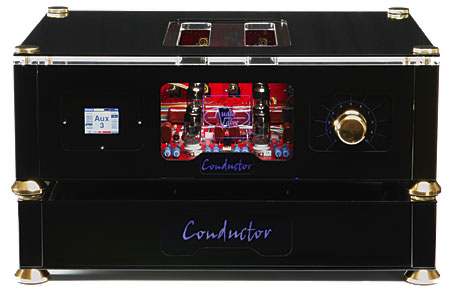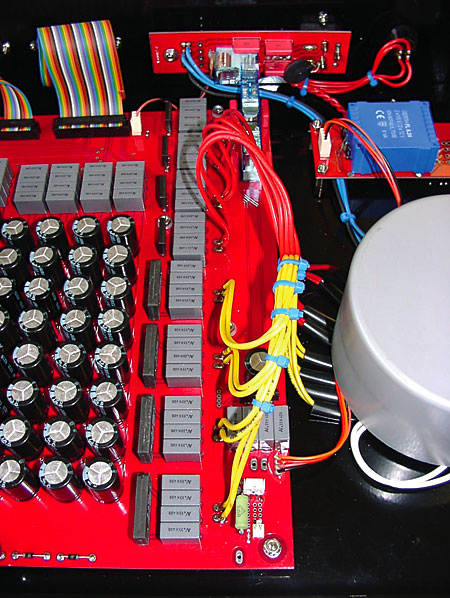| Columns Retired Columns & Blogs |
Audio Valve Conductor preamplifier
We audio writers have our niches. Mikey loves analog, Artie likes to play with horn speakers and assorted oddball British kit, and I really enjoy reviewing affordable speakers. There's something exciting about hearing the fruits of the labors of a creative designer who's applied his talents to meet a stringent price point and created a speaker that can entice into our hobby the financially challenged music lover.
Footnote 1: The mono copy of this masterpiece that I purchased in 1959 was the first item in what has since become a collection of some 12,000 LPs. I thank Michael Fremer for finding me a copy of the stereo version about 10 years ago.

But I have another passion: expensive tube gear. I so enjoyed my time reviewing the Audio Research Reference 110 amplifier that I bought the review sample (see my review in the August 2007 issue), and when ARC's William Z. Johnson insisted that I listen to the Reference 110 together with ARC's Reference 3 line stage, I got a kick out of comparing the Ref 3 with my own reference line stage, the Audio Valve Eclipse.
Although I was stunned by the refined level of musical realism of the Reference 3 ($10,000), I was also surprised that the Eclipse ($4200) held its own, despite being less than half the ARC's price. In fact, I was so surprised that, when the ARC went back home to Minnesota, I was quite happy to keep on listening to the Audio Valve. Still, I was scratching my head: If the Eclipse is this good, what would a cost-no-object line stage from Audio Valve's Helmut Becker sound like?
Turned out I'd be given an opportunity to find out. I later received a call from Audio Valve's US distributor, Ray Lombardi of Ray of Sound, who told me that AV had designed a "statement" line-stage preamplifier, the Conductor, which would cost $13,995 in the US. Would I be interested in hearing it?
As I dashed off a quick e-mail to John Atkinson—"Please? Please!? Please?!?"—my hands were trembling.
The design is fascinating
A conversation with Heike Becker, Helmut's business partner, revealed the Conductor's origins. It seems that Audio Valve's German dealers and overseas distributors were clamoring for a line-stage preamp that could be paired with AV's top-of-the-line Baldur 300 and Challenger 400 monoblock amplifiers. Designer Becker began with a clean sheet of paper and three requirements: The new preamp needed to be a completely balanced design with fully symmetrical circuitry, to have an outboard power supply with massive storage, and to be completely dual-mono, even down to the power supply. Becker then proceeded to make the finest preamp he could.
The Conductor operates in full class-A with no feedback. Its balanced preamplification circuit, which provides 14dB of gain to all line inputs, uses four 6922 tubes to amplify each phase of each channel, followed by a motorized ALPS potentiometer, followed by four 6N6P (6H30) tubes in the second amplification stage. There are two outputs and six line-level inputs, each of which can be balanced or single-ended. The elegant but minimalist remote control enables switching of all but one of the inputs, as well as volume, mute, and power. One nice feature is that a microprocessor remembers the volume setting for each input, to minimize the risk of blasts of high-volume blasts when switching among sources with various output levels. There's also a usage meter, calibrated in hours, accessible only via the front panel.
The separate power supply provides 100,000µF of capacitance for the filament circuits, and an additional 10,000µF for the anode circuits. The large toroidal transformer is shielded from static and magnetic effects and supplies eight separate conductor paths: four each for the filaments and anode circuits. The power supply also includes polypropylene capacitors as RF blockers, as well as eight low-resistance voltage regulators to remove ripple from the filament circuit and supply clean voltage.

All capacitors in preamp and power supply are proprietary designs made exclusively for Audio Valve. The units communicate via two umbilicals terminated with printer-style connectors. Although the preamp is designed to sit atop the power supply, Audio Valve and Ray of Sound will provide umbilicals of any length for those who want to separate them.
As the Conductor operates in class-A, which usually generates a lot of heat, Becker suggests that neither power supply nor preamp be placed on a thick carpet, and that the top of the preamp be given adequate ventilation. The units are each 20" wide, which will be too wide for many component racks.
I admire Helmut Becker for designing the best model he could with no concession to any expectations his customers might have had of how a preamp should look. Stacked atop its outboard power supply, the Conductor is unusually large and heavy—far more so than my ARC Reference 110 power amp. The preamp's physical appearance is striking, impressive, and eccentric. I think it's gorgeous, though not every visiting audiophile agreed.
Available in light gray with silver accents or black with gold accents, it sports a central window through which the tubes and circuit boards are visible. The volume pot is to the right; to the left, a color TFT screen displays various types of input, volume, and other data. The Conductor doesn't look mass-produced but handmade—akin to the product of a brilliant, wealthy, mad scientist who has spared no expense.
My only complaint about the Conductor's physical layout is that the display (about as large as a cell-phone's) wasn't easily read by this bifocals wearer unless I stood right in front of the preamp and bent over to peer at it. Other than seeing which input is engaged and looking at the bargraph that shows the selected volume, it's not critical to be able to read the display, but it would be nice if it were a bit larger.
The turn-on procedure has four steps. Flipping on a switch on the preamp section's rear panel puts it into Sleep mode: "Conductor" appears in red on the power supply, while the word remains dark on the preamp itself. Hitting the On/Off button on the remote, one of the toggle switches on the front panel, or the center of the display puts the preamp in Mute mode. On both power supply and preamp, "Conductor" then turns from red to dark blue. The display shows a picture of a tube and a thermometer that changes from black to red to yellow as the filaments heat up. When the thermometer reaches 75%, the tubes' plate voltage of the tubes is applied. When the thermometer reaches 100%, the preamp switches itself to Operate mode and the screen displays the input selected. It sounds complicated, but it's simple, and cool to watch.
Footnote 1: The mono copy of this masterpiece that I purchased in 1959 was the first item in what has since become a collection of some 12,000 LPs. I thank Michael Fremer for finding me a copy of the stereo version about 10 years ago.
- Log in or register to post comments




































